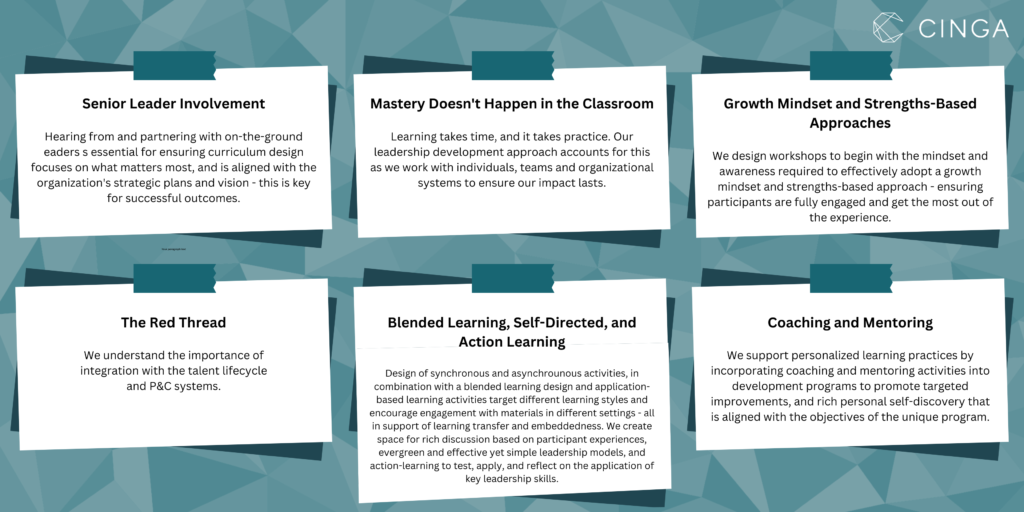Organizations invest billions in leadership development programs every year.
There are many skeptics out there who question whether corporate leadership training delivers tangible results.
What do these programs truly accomplish? Do they meaningfully change leaders, and if so, how long do these changes last?
Effective leadership development takes more than simply investing in training programs.
It requires a systemic approach that aligns organizational structures, management practices, and individual development.
And it requires the often overlooked step of measuring ROI to demonstrate that the investment in leadership development is worth it.
When done well, these programs can lead to personal and professional growth, greater meaning and purpose, enhanced happiness, and reduced stress – ultimately enhancing employee engagement and effectiveness, and empowering leaders to better support their teams and organizations.
Let’s look at how.
Measuring Tangible Performance Improvements
Making sure leadership development programs lead to tangible performance improvements means beginning with the end in mind. How will you measure success?
The Kirkpatrick Model is widely recognized and provides a structured approach for evaluating development programs. It consists of the following four levels:
- Level 1: Reaction – This first stage gathers immediate reactions. Often called “smile sheets,” these evaluations capture how much participants enjoyed the program, how relevant they found the content, and the quality of the facilitation.
- Level 2: Learning – The next level measures the extent to which participants have acquired intended knowledge, skills, and attitudes. Assessment instruments, tests or practical evaluations issued before and after can deliver these results. Many organizations struggle to reach this level, but it’s crucial – it demonstrates whether development programs have effectively transferred new knowledge.
- Level 3: Behavior – Behavioral change is the real test of effective development. This level evaluates whether participants apply what they’ve learned when they return to their jobs. This involves observing on-the-job performance and gathering feedback from peers and supervisors over time.
- Level 4: Results – The ultimate measure of a development program’s success is its impact on organizational performance. This highest level of evaluation focuses on tangible results that can be mapped back to the programs – like increased productivity, improved employee engagement, higher sales, or reduced costs.
With the appropriate data – retention rates, internal promotion stats, 360s or team evaluations – you can see whether your leadership development programs truly effect change.
You can also confirm for yourself whether or not you’ve made the right investment – including choosing the right partner.
Is your provider talking about levels 1,2 or are they flagging levels 3 and 4?
How to Use Measurement to Get Results
Too many organizations stop at the first level of evaluation, yet the true value of a leadership development program is only fully realized at levels three and four.
Here are some practical steps to make sure your leadership development programs deliver measurable results at the highest levels of the Kirkpatrick framework:
- Set measurable learning objectives: Define what success looks like from the beginning. Establish specific, measurable goals for your program that align with the organization’s strategic goals. Most importantly, make sure the leadership team is aligned around clear values and an inspiring strategic direction.
- Get Senior Leader Sponsorship: Hearing from and partnering with on-the-ground leaders is essential for ensuring curriculum design focuses on what matters most and is aligned with the organization’s strategic plans and vision. This is key for successful outcomes.
- Measure and maintain change: Implement a system for long-term evaluation to track sustained impact of development programs on both participants and the organization. This could involve engagement metrics, performance reviews and key performance indicators aligned with program objectives. Use these metrics to evaluate individual and organizational performance and adjust systems to maintain improvements.
- Communicate results: Share results with stakeholders, including organization leadership and participants. Highlight success stories and data that demonstrate the program’s impact on both individual and organizational performance.
Mastery doesn’t happen in the classroom. Learning takes time, and it takes practice.
The 70-20-10 model is a framework for learning and development that emphasizes the importance of a diversified approach to gaining skills and knowledge.
According to this model:
- 70% of learning comes from on-the-job experiences
- 20% from interactions with others
- 10% from formal educational events.
The idea is that real-world, hands-on experiences are the most effective way to learn, as they allow individuals to apply what they have learned in practical situations, solve problems, and make decisions that enhance their capabilities.
Here are some tips for implementing the 70-20-10 approach:
- Offer sustainment activities: Provide ongoing support to participants after workshops. This could include coaching, mentoring, or additional resources to reinforce what they’ve learned and encourage behavioral change. Remember 70% of learning comes from on-the-job experiences, 20% from interactions with others, and only 10% from formal educational events.
- Encourage self-reflection and meaning-making: Leadership development programs should offer teams the chance to pause and reflect, which can lead to renewed purpose and effectiveness. Encouraging leaders to “press the pause button” allows for meaningful insights and shifts in perspective.
- Address psychological barriers to growth: Not all leaders – or potential leaders – are equally open to self-improvement. Fostering a learning environment and mindsets conducive to learning is key right from the start. Tailoring programs to individual readiness for growth can help people overcome these barriers.
- Focus on whole-person growth: Leadership development should go beyond teaching specific skills to cultivating broad capabilities like self-awareness and resilience, which are essential for adaptive leadership. Effective programs transform not just job performance, but the leaders’ whole selves.
Interactions with others, including coaching, mentoring, and networking, provide valuable feedback and insights, while formal education, such as courses and training programs, offers foundational knowledge and theoretical understanding.
By focusing primarily on experiential learning and social interactions, this approach encourages a more dynamic and integrated learning environment. It helps employees to develop practical skills and knowledge that are directly applicable to their roles, while also benefiting from the guidance and expertise of their peers and mentors.
The formal education component, although smaller, ensures that employees have a solid grounding in essential theories and concepts, which can then be enhanced and expanded upon through real-world application and collaborative learning.
Measuring what matters in leadership development isn’t a nice-to-have – it’s essential for making sure these programs deliver real value.
We need to understand immediate reactions and we need to assess the long-term impact on behavior and organizational results.
Our leadership development approach accounts for this as we work with individuals, teams, and organizational systems to ensure our impact lasts.
For any organization committed to cultivating strong leaders, focusing on what truly matters will pave the way for long-term, sustainable success and growth.


